
Why should you care about negative mix effects in the first place?
Negative mix effects occur when there is a negative impact on the overall performance or profitability of a product or business due to changes in the product mix. These negative mix effects can arise from various factors such as changes in customer preferences, shifts in market demand, or inefficient allocation of resources.
So, if you dread implementing any changes to your product mix and are doing a lot of calculations manually or you might even have a sophisticated tool for combating this, but it doesn’t seem to be yielding results, you are at the right place.
No matter if you are managing revenue for beverages, dairy, cosmetics, tobacco, or any other product, increasing profit margins is one of the key things on your mind for sure.
What is also important to note is that tracking negative mix impacts helps in assessing the overall profitability of a brand or product portfolio. It provides insights into which products or segments are dragging down profitability and allows managers to take corrective actions sooner rather than later.
Well said here by BCG, a lot of FMCG companies agree that managing the SKU mix is the key lever for ensuring that pricing strategies bring year-over-year benefits—as much as 1% to 2% in pricing improvement annually.
However, at the same time, something completely the opposite is happening — a lot of FMCG companies are not disciplined in the execution of their mix strategy and are missing out on these huge opportunities.
So, how can you save or increase your market share as well as profit margins, by strategically choosing products that win, and how do you find these profit opportunities?
However, before diving deeper, we suggest this pre-read.
Which products are profit drainers, and which are profit drivers?
To increase your profitability, you’ll need to identify which products are accelerating your profit growth and which are draining it, or essentially which combination of products is creative negative effects.
One of the ways to mitigate any further profit loss is knowing when the product in the mix has reached a certain point after which it is losing too much for you. How neat would it be if you could get a simple message each time a negative mix effect happens?
For us, this isn’t too complicated at all. You can set up an alert on mix effects on our platform and be informed about it as soon as it happens.
Based on the KPI you have set inside the alert for mix impact, you can trigger the alert on a brand, category, or channel level to monitor negative mix changes for your company.
The alert for negative mix effects would look something like this:
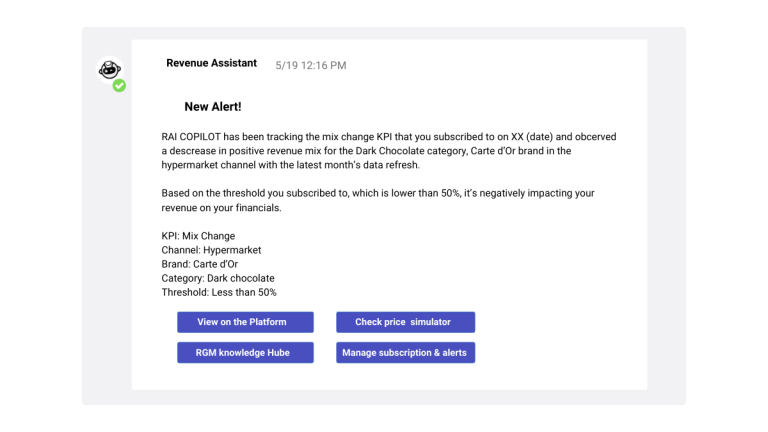
Wondering where this alert came from? From your future RAI Copilot, working with you inside of Microsoft Teams, WhatsApp, or any other messenger you like. 😊
Just kidding, but, now seriously, if this one becomes a tool of your choice, the Copilot will send you an alert as well as to other subscribed users for negative mix effects notifications, giving you a chance to mitigate this risk and act immediately on the negative mix effects.
Now that you understand where the issue is coming from you can put your strategic thinking glasses on, and dive into crafting the solution with our Copilot.
If the word Copilot peaked your interest, then you might want to read about conversational AI here.
Reviewing the High-Level Variance Dashboard
As you could also see in the previous image, there is an image to view the detailed analysis behind the sent alert via Teams. After clicking on the View on Platform button inside the alert, you will be taken to the in-depth analysis of the high-level revenue variance dashboards.
First, you can review the stats for total company performance and then you can go deeper for each brand and identify the gaps that are causing a negative mix on your revenue (profit). You will notice that Mondelez is used as an example, but the data is here just for showcasing purposes only.
Below is what you will see first, as a first step in investigating negative mix effects:

This overview gave us enough general insights on what the problem is; now we need to drill down into more detail.
In depth analysis review
To learn more, so we can move to the decision-making, we can deep dive into the mix management detailed view, as shown below, by typing in the relevant search words inside the cognitive search (upper right part of the image, inside the search bar):
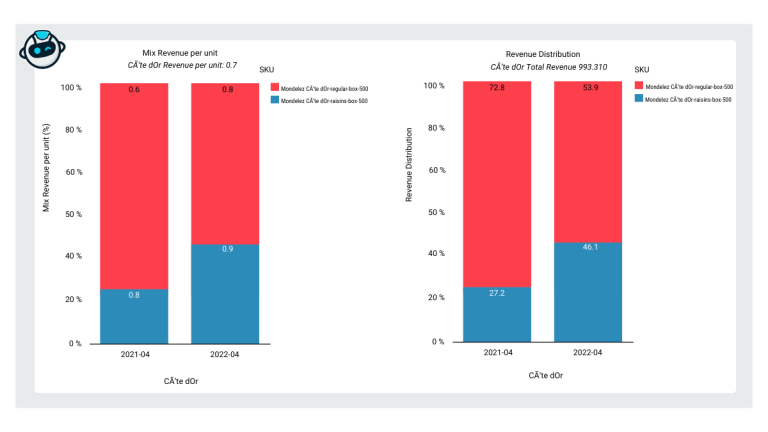
We can see that there are two products (Regular Box 500 and Raisin’s box 500) in the brand category in this exemplary data analysis, and what we can observe is that Regular Box 500 has a negative mix effect (-176k) and makes for almost half of the revenue.
There is also a detailed analysis of drainers and drivers available for you to take a look at as well:

After taking a closer look, we can see that the Carte D’or brand has the lowest average revenue per unit in this category for Mondelez by checking the last graphic, which is 0.8.
Essentially, this product is taking up too much space in our mix and is most probably creating negative mix effects.
Additionally, at the same time, Carte D’or is the third biggest brand in the category, so that means we are selling this brand cheaper than the average of the category revenue, which is causing negative mix effects and therefore revenue loss.
What is neat is that if you’d like to further self-train yourself on this topic, you can go to the cognitive search again and find the Mix Playbook, that we have available inside the platform.
With a simple Google-like search, you get instant access to it and learn how to mitigate negative mix effects.
Besides other useful things in the playbook, you will learn that, in the context of business operations, negative mix effects can result in decreased sales volume, lower profit margins, and reduced customer satisfaction.
For example, if you experience a decline in demand for one of its high-margin products and an increase in demand for lower-margin products, you may face challenges in maintaining profitability.
Negative mix effects can also occur when there is a mismatch between production capacity and product demand. This can lead to underutilization of resources and increased costs.
Additionally, if a company fails to adapt its product offerings to changing customer needs and preferences, it may lose market share to competitors who are better able to meet those demands.
To mitigate negative mix effects, businesses need to closely monitor market trends and customer preferences. You should regularly assess their product portfolio and make necessary adjustments to align with changing demands. Effective resource allocation strategies can also help optimize production capacity and minimize inefficiencies.
By proactively addressing negative mix effects, you can maintain competitiveness in the market and ensure sustainable growth.
While we’re at growth topic, cognitive AI is an indispensable enabler of capability growth for revenue management, which is especially showcased with the self-training options. Read more on this topic here.
Now, without further ado, what would be the corrective actions we could take immediately to turn around the negative mix effect?
Taking immediate action to turn around the negative mix effect
To try to turn around the negative mix effects into positive ones, let’s first go to the pricing simulator. Why go with pricing? Well, as is well explained in this article, we know that the product mix effects, therefore the negative effects, too, rarely occur on their own, as products will have different amounts of price erosion and changes in quantity (known as volume).
So, there is a need to find a sweet spot that will have the right balance between the price and volume, which you would be happy with. With the power of advanced simulations and data analytics, this is possible and is much easier than any type of manual or Excel calculations.
Unlock the power of price simulations
Going back to the cognitive search again, as it is the easiest way to pop it up quickly, as shown below, we’ll land on the pricing simulator:
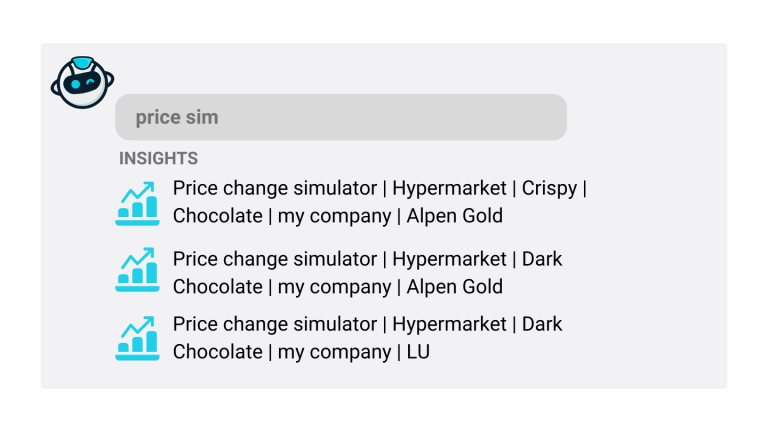
Then, there are options to choose the simulation scenario percentage as well as COGS percentage. You can play around with these numbers, as the simulations pop up pretty quickly, giving you access to instant results.
Aaaaand, ta-da:

We can see the mix impact, and we can check if the mix effects are now positive or negative, if we switch to the button on the right here as well:
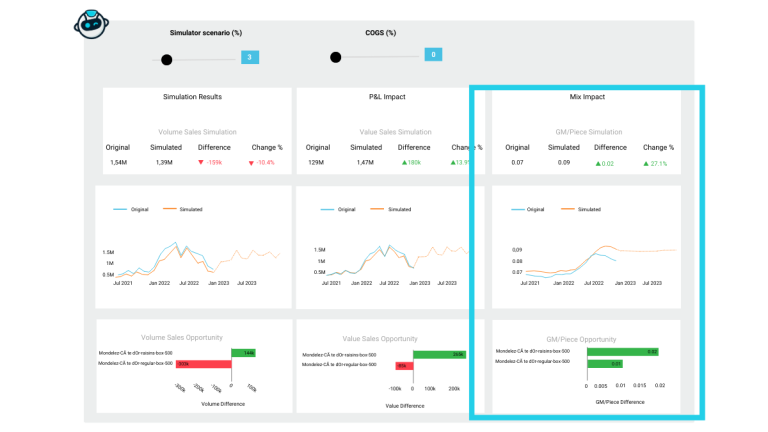
After applying 3% price increase, or any other you’d like to test out (in this case, this one worked well) with 0% COGS change, we can observe that value, volume, and mix effects analysis outputs turn to (+) for the analyzed products.
If this got you excited but you are unsure how to perform the mix effects analysis live or would like to save time on the search, you can bookmark the simulation result page, and share it later with your team, and easily showcase the negative mix effects analysis you did.
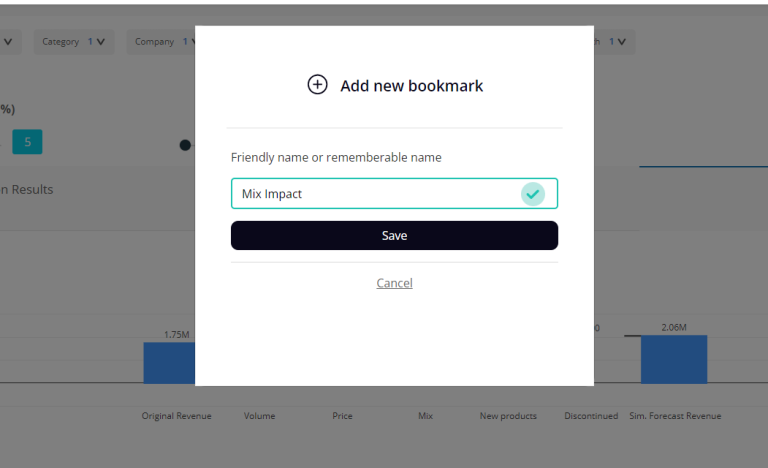
Experience the Power of Our Platform with Your Own POS Data
Finally, we hope that we got you excited about this solution and that you are at least a bit curious about how this mix effects investigation would look with your own data. We can make that happen if you’d be open to sharing your POS data and injecting it into our platform. Goes without saying that we would make sure to keep your data private.
We invite you to get in touch today and stop losing revenue from negative mix effects starting today.






